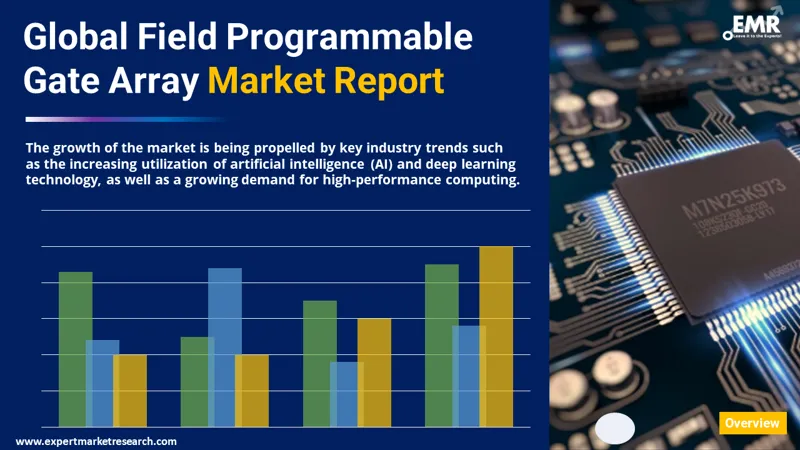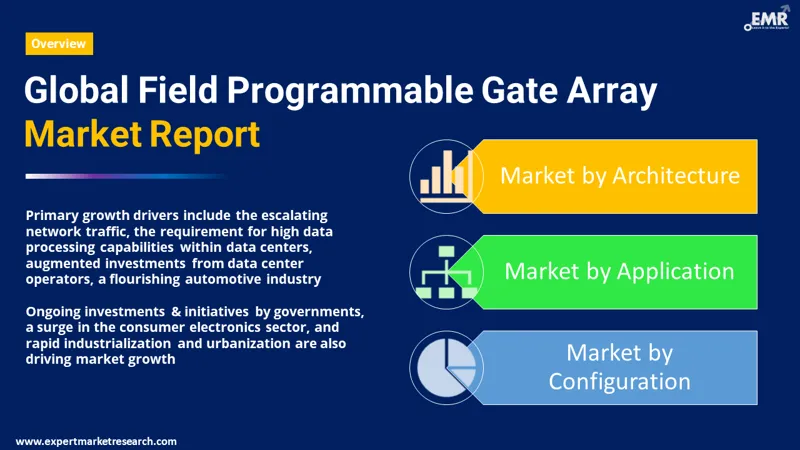
Consumer Insights
Uncover trends and behaviors shaping consumer choices today
Procurement Insights
Optimize your sourcing strategy with key market data
Industry Stats
Stay ahead with the latest trends and market analysis.
The global field programmable gate array market is expected to grow at a CAGR of 7.70% in the forecast period of 2026-2035, in terms of value.
Base Year
Historical Period
Forecast Period
Compound Annual Growth Rate
7.7%
2026-2035
*this image is indicative*
| Global Field Programmable Gate Array Market Report Summary | Description | Value |
| Base Year | USD Billion | 2025 |
| Historical Period | USD Billion | 2019-2025 |
| Forecast Period | USD Billion | 2026-2035 |
| Market Size 2025 | USD Billion | XX |
| Market Size 2035 | USD Billion | XX |
| CAGR 2019-2025 | Percentage | XX% |
| CAGR 2026-2035 | Percentage | 2025% |
| CAGR 2026-2035 - Market by Region | Asia Pacific | 8.4% |
| CAGR 2026-2035 - Market by Country | USA | 8.0% |
| CAGR 2026-2035 - Market by Country | UK | 7.9% |
| CAGR 2026-2035 - Market by Architecture | SRAM | 8.7% |
| CAGR 2026-2035 - Market by Configuration | High-range FPGA | 8.8% |
| Market Share by Country 2025 | France | 3.2% |
By architecture, the market is segmented into SRAM, anti-fuse, and flash, among others. In the past years, the static random-access memory (SRAM) segment produced the most revenue, owing to its greater versatility, re-programmability, high integration, and high performance for a variety of applications. The widespread use of SRAM-based field programmable gate arrays in military and aerospace, telecommunications and wireless communication networks, and consumer products has been propelling the segment forward. However, anti-fuse FPGAs are more reliable than SRAM-based arrays, particularly in radiation-prone environments. Because of their quicker boot time and better reliability, the anti-fuse segment is projected to expand significantly over the forecast era.

Read more about this report - REQUEST FREE SAMPLE COPY IN PDF
As SRAM-based field programmable gate arrays are extremely volatile and require a dedicated power source to store data, the industry leaders are constantly working to produce innovative SRAM memory technology to simplify FPGA-based products and address this challenge. Meanwhile, flash-based FPGAs are expected to be the most widely deployed architecture-type over the projected timeframe.
The Asia Pacific is projected to be one of the most attractive regions for the players operating in the field programmable gate array industry. Within the Asia Pacific, many nations including China, Taiwan, South Korea, and others have seen a massive increase in the consumer electronics industry in the past few years. As a result, the FPGA market in the area is seen as a leverage point. Furthermore, rapid industrialisation and urbanisation across the region open up new opportunities for area FPGA industry players. China had the highest revenue share in the country, owing to the government's ongoing investments and initiatives to boost the industry's growth. For example, in March 2018, China established a USD 28.9 billion government-backed semiconductor fund to support the country's chip industry. This effort focuses on creating new commercial prospects by manufacturing FPGAs, central processing units, and memory chips.
North America is another significant region for the product. Because of its thriving car industry, the region is projected to expand significantly. In November 2018, the Semiconductor Industry Association (SIA) announced the signing of the United States-Mexico-Canada Agreement (USMCA). The agreement is expected to promote open trade, which means that more engineering goods will be manufactured in America, such as semiconductors, and will be exported to clients all around the world. In the coming years, such contracts are likely to fuel business demand.

Read more about this report - REQUEST FREE SAMPLE COPY IN PDF
A field-programmable gate array (FPGA) is an integrated circuit that can be programmed by a customer or a manufacturer after it has been manufactured, hence the name. A hardware description language (HDL), equivalent to that used with application-specific integrated circuits, is used to specify the FPGA setup (ASIC). Previously, circuit diagrams were used to define the structure, but with the advent of electronic design automation methods, this is becoming less common. FPGAs have an assortment of programmable logic blocks and a hierarchy of "reconfigurable interconnects" that allow blocks to be "wired together," similar to how many logic gates can be inter-wired in various configurations. Complex combinational functions can be performed using logic blocks, or basic logic gates like AND and XOR can be used.
By architecture, the market is divided into:
Based on configuration, the market is segmented into:
On the basis of application, the market is categorised into:
The regional markets for the product include:
| CAGR 2026-2035 - Market by | Country |
| USA | 8.0% |
| UK | 7.9% |
| Australia | 7.5% |
| Brazil | 7.4% |
| Germany | 7.3% |
| Canada | XX% |
| France | XX% |
| Italy | XX% |
| China | XX% |
| Japan | XX% |
| India | XX% |
| Saudi Arabia | XX% |
| Mexico | 7.0% |
The industry is being fuelled by the increasing penetration of AI and deep learning technology, coupled with the rising demand for high-performance computing around the world. After manufacturing, a field programmable gate array, that is, is a semiconductor system can be programmed and reprogramed to meet the desired functionality and application requirements. Because of these characteristics, it is more adaptable than competing technologies, such as application-specific standard products (ASSPs) and complex programmable logic devices (CPLDs). FPGA devices have gained popularity in AI workstations, edge AI devices, and high-performance computing (HPC) applications due to their high performance, cost efficiency, and energy efficiency.
The FPGA market is seeing rapid growth due to rising network traffic and the need for high data processing across datacentres. FPGA systems are used in a variety of data centre hardware, including disc and server cabinets, as well as networking equipment. These systems assist data centre hardware in lowering network latency and optimising storage and processing applications. The increased investments by data centre operators in the construction of new facilities would further expand business opportunities in the forecast period.
The report gives a detailed analysis of the following key players in the global field programmable gate array market, covering their competitive landscape, capacity, and latest developments like mergers, acquisitions, and investments, expansions of capacity, and plant turnarounds:
The comprehensive EMR report provides an in-depth assessment of the market based on the Porter's five forces model along with giving a SWOT analysis.




*While we strive to always give you current and accurate information, the numbers depicted on the website are indicative and may differ from the actual numbers in the main report. At Expert Market Research, we aim to bring you the latest insights and trends in the market. Using our analyses and forecasts, stakeholders can understand the market dynamics, navigate challenges, and capitalize on opportunities to make data-driven strategic decisions.*
Get in touch with us for a customized solution tailored to your unique requirements and save upto 35%!
The market is projected to grow at a CAGR of 7.70% between 2026 and 2035.
The major drivers of the market include the rising network traffic, need for high data processing across datacentres, increased investments by data centre operators, thriving car industry, government's ongoing investments and initiatives, increase in the consumer electronics industry, rapid industrialisation and urbanisation.
The increasing penetration of artificial intelligence (AI) and deep learning technology, coupled with the rising demand for high-performance computing are the key industry trends propelling the market's growth.
The major regions in the industry are North America, Latin America, the Middle East and Africa, Europe, and the Asia Pacific.
By architecture, the market is divided into SRAM, anti-fuse, and flash, among others.
Based on configuration, the market is segmented into low-range FPGA, mid-range FPGA, and high-range FPGA.
Field programmable gate array find their major application in telecommunication, consumer electronics, industrial, aerospace and defence, and automotive, among others.
The major players in the industry are Xilinx, Inc., QuickLogic Corporation, Achronix Semiconductor Corporation, Efinix Inc, and Intel Corporation, among others.
Explore our key highlights of the report and gain a concise overview of key findings, trends, and actionable insights that will empower your strategic decisions.
| REPORT FEATURES | DETAILS |
| Base Year | 2025 |
| Historical Period | 2019-2025 |
| Forecast Period | 2026-2035 |
| Scope of the Report |
Historical and Forecast Trends, Industry Drivers and Constraints, Historical and Forecast Market Analysis by Segment:
|
| Breakup by Architecture |
|
| Breakup by Configuration |
|
| Breakup by Application |
|
| Breakup by Region |
|
| Market Dynamics |
|
| Competitive Landscape |
|
| Companies Covered |
|
| Report Price and Purchase Option | Explore our purchase options that are best suited to your resources and industry needs. |
| Delivery Format | Delivered as an attached PDF and Excel through email, with an option of receiving an editable PPT, according to the purchase option. |
Datasheet
One User
USD 2,499
USD 2,249
tax inclusive*
Single User License
One User
USD 3,999
USD 3,599
tax inclusive*
Five User License
Five User
USD 4,999
USD 4,249
tax inclusive*
Corporate License
Unlimited Users
USD 5,999
USD 5,099
tax inclusive*
*Please note that the prices mentioned below are starting prices for each bundle type. Kindly contact our team for further details.*
Flash Bundle
Small Business Bundle
Growth Bundle
Enterprise Bundle
*Please note that the prices mentioned below are starting prices for each bundle type. Kindly contact our team for further details.*
Flash Bundle
Number of Reports: 3
20%
tax inclusive*
Small Business Bundle
Number of Reports: 5
25%
tax inclusive*
Growth Bundle
Number of Reports: 8
30%
tax inclusive*
Enterprise Bundle
Number of Reports: 10
35%
tax inclusive*
How To Order

Select License Type
Choose the right license for your needs and access rights.

Click on ‘Buy Now’
Add the report to your cart with one click and proceed to register.

Select Mode of Payment
Choose a payment option for a secure checkout. You will be redirected accordingly.
Gain insights to stay ahead and seize opportunities.

Get insights & trends for a competitive edge.

Track prices with detailed trend reports.

Analyse trade data for supply chain insights.

Leverage cost reports for smart savings

Enhance supply chain with partnerships.

Connect For More Information
Our expert team of analysts will offer full support and resolve any queries regarding the report, before and after the purchase.
Our expert team of analysts will offer full support and resolve any queries regarding the report, before and after the purchase.
We employ meticulous research methods, blending advanced analytics and expert insights to deliver accurate, actionable industry intelligence, staying ahead of competitors.
Our skilled analysts offer unparalleled competitive advantage with detailed insights on current and emerging markets, ensuring your strategic edge.
We offer an in-depth yet simplified presentation of industry insights and analysis to meet your specific requirements effectively.
Share